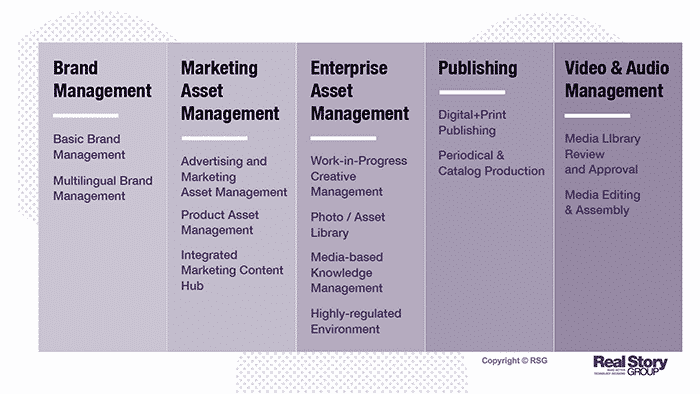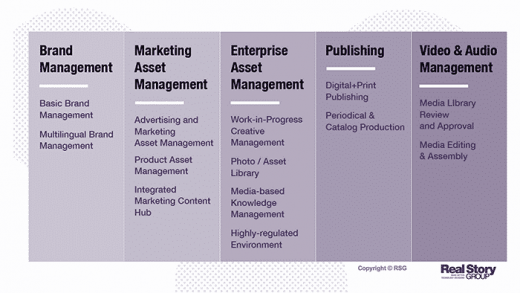The Real Story on MarTech: The case for Digital Asset Management
How do you know if your organization needs Digital Asset Management? Here’s a checklist.
A picture tells a thousand words, right? Yet many marketers struggle to find and deploy the right imagery and videos for marketing campaigns and personalization programs. Too often they turn to outside agencies to recreate visuals at great expense, rather than figure out how to access all the diverse assets their firm has already created.
While some of the most sophisticated enterprises have figured out how to effectively manage assets, some of you are just starting out on this journey. I regularly hear marketers and IT people say, “I just need something that’s better than Dropbox or Box to manage our digital assets.”
Yet when really pressed, these same people realize that their needs are more nuanced than just a better Dropbox. They are really looking for the functionality Digital Asset Management (DAM) systems were built to provide.
Paying the price
Why specialize here? Because in an era of visual story-telling, managing digital assets is no longer a “nice to have” but a “must have” for digital marketing. Yet even today the rapid growth of digital media-driven experience needs can catch enterprises by surprise, and martech stack leaders often bear the burden of absent asset management services in their stack.
Part of the problem lies at a senior management level, where I’ve found most organizations lack understanding and perspective on the severity of the problem. They don’t recognize its impact on the business and the value that DAM technology can provide. So let’s look at business rationales and then specific problems to solve.
Three rationales
At RSG we’ve seen three major rationales for investing in a DAM tool. At a high level, enterprises face pressure to do the following:
- Reduce costs and risks;
- Generate new revenue opportunities; and
- Improve market or brand perception and competitiveness.
Cost reduction implies greater operational efficiency. You do more with what you have, do the same or more with less than what you have, or wring out costs by optimizing or changing processes. Greater operational efficiency entails increased communication and collaboration; automation; and sharing of resources, systems, and processes.
Keeping important assets under management also reduces your brand and compliance risks, and allows you to apply policies to where and how assets get used, and disposed. This becomes particularly important when you license rights for external creative assets.
New revenue generation requires developing new products or services, finding new or expanded uses for existing products and services, or uncovering new or adjacent markets for existing products. At the core, this process requires operational agility. The organization must have the internal drive and collaboration to change processes and make things happen; the infrastructure must facilitate a quick response to new opportunities.
All enterprises need to produce, manage, and deliver an increasingly broad set of collateral information for each new or revised offering. In other words, your digital and media assets need to evolve and adapt as fast as your revenue streams, and that takes proactive management.
DAM pain points: A quick quiz
How do you know if you need Digital Asset Management technology in your enterprise? Let’s try a quick quiz — how many of these challenges resonate with you?
- You can’t find an image, video, or a piece of media that someone else needs right now.
- Your asset production or distribution process — or some large part of it — isn’t streamlined.
- Too many silos of disconnected, localized “libraries” don’t work together.
- Systems for managing the particularities of video — especially high-definition (HD) video — are lacking.
- Multiple informal systems duplicate or complicate efforts to manage at an enterprise level.
- You can’t readily share media across projects, groups, divisions, partners, or channels.
- Your marketing messages aren’t presented consistently across groups, organizations, verticals, and target markets.
- Your logo is misused, or your brand is inconsistently displayed.
- You want your social, web, mobile, and email marketing channels to work off the same set of base assets for a combined campaign, but they cannot today.
- You have a rich set of images but want to just find those with a particular shade of, say, orange.
- The collaboration, review, and approval cycle is slow, inefficient, and manual; the material isn’t in a form that everyone can review, especially partners or legal reviewers outside the company.
- External or internal specialists frequently re-create content, artwork, layouts, slides, presentations, and assets — starting from scratch even when something already exists.
- Your team can’t respond rapidly to partners, distributors, customers, or clients who need your assets to help you drive revenue.
- Tracking revisions of works in progress or finished works is difficult — are you working with the latest approved version?
- You need multiple different renditions of an asset but don’t have time to make them manually.
- You can’t propagate changes to a source asset to all the derivative variants.
- You can’t track asset use — where it’s used, who is using it, and how frequently it’s used.
- Confusion reigns around the (manual) tracking of licensed photos, images, or other assets.
- Your firm was docked or fined for violating the usage rights of a licensed asset because no one knew the rights, which weren’t attached the image, and couldn’t be readily looked up.
- Product imagery is showing up differently in your e-commerce (or related) platform, compared to the rest of your digital properties.
For how many of those twenty bullets did you check “yes?” If it was more than eight, you probably need a DAM platform, or to revisit your current DAM implementation.
Business scenarios
But how do you know which DAM technology is right for you? As usual, at RSG we’re going to suggest filtering by business scenarios. It’s a measure of the potential richness of these solutions that there are more than a dozen business scenarios for DAM.

That said, the typical DAM platform only excels at only four to six of these scenarios, so you’ll want to prioritize carefully. There’s also a complexity spectrum here: solutions for brand asset management are typically simpler and cheaper than those that support compound marketing asset management or video and audio (media) management.
For a deeper dive, check out this series of posts that describe these use cases in more detail.
Coming full circle
Thus far I’ve been talking about the benefits side, but there’s an expense side to the ledger too. When making your case for DAM, be sure to include a realistic total cost of ownership, accounting for key non-technical costs such as business analysis, education, support, asset clean-up, taxonomy/metadata development, change management, and program management to name a few. As with other technology platforms, the DAM technology itself is typically a small percentage of your overall cost of asset management operations.
There’s one role in particular you need to account for, and it might be new in your organization: librarians. You need someone to manage your assets, ensure they are categorized correctly, findable, and cleaned up from time to time. Your DAM repository is like a library, and libraries don’t function long without librarians.
Which brings us full circle. The larger story here is that content management is critical to omnichannel marketing. So make sure you account for asset management in your marketing technology stack, but also make sure you account for suitable asset management resources for your marketing operations team.
Real Story on MarTech is presented through a partnership between MarTech and Real Story Group, a vendor-agnostic research and advisory organization that helps enterprises make better marketing technology stack and platform selection decisions.
The DAM playbook: Getting the most out of your digital asset management system: Coming up at MarTech
The post The Real Story on MarTech: The case for Digital Asset Management appeared first on MarTech.
(31)



